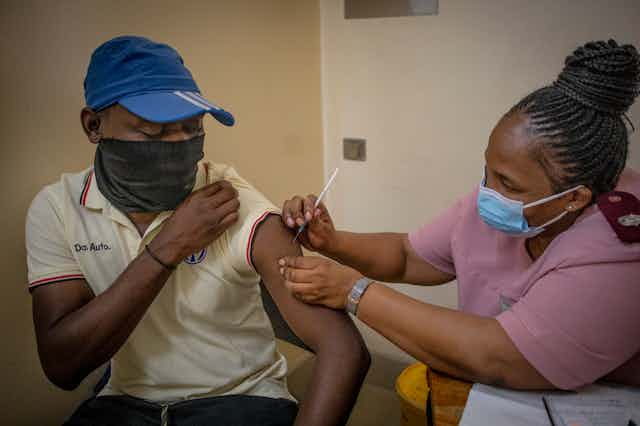Recent official South African medical reports and countrywide COVID data have indicated that since early November, when omicron was first detected, COVID cases substantially increased. However, most patients had, at worst, mild symptoms, and cases are now in steep decline. These observations substantially differ from the previous waves, including those attributed to the delta variant.
Reporters also stated that even though vaccinated and unvaccinated people developed the disease in roughly equal numbers, most hospitalised patients were unvaccinated. And although the current South African COVID wave may be coming to an end, South Africa’s omicron wave experiences may follow very similar patterns in other countries.
In contrast to this relatively encouraging news, some recent tweets and localised reports suggest that some hospitals in South Africa have experienced – or are experiencing – increasing numbers of hospitalised patients, with increasing numbers of patients requiring treatment in intensive care units and needing mechanical ventilation – a key indicator of severe COVID.
What we need to consider in the South African data to determine if omicron was responsible for the recent South African COVID cases and deaths, is: does omicron cause less serious disease than delta and will omicron waves be shorter in duration than delta waves?
A review of official South African COVID countrywide figures from December 1 2021 to December 21 2021 shows new confirmed COVID cases per million population rose dramatically from 63 to 303 (a 380% increase), while total deaths only rose from 0.466 to 0.583, (a 25% increase). At the same time, the rate at which all COVID infections were estimated to spread (the R rate) steadily decreased to around 54% of the December 1 value.
Can we be sure that omicron was a major contributor to the recent South African COVID wave?
Some countries, such as the UK, have substantial national initiatives that allow monitoring of the shifting genetics of SARS-CoV-2 variants and provide almost real-time data to help confirm both variants in patients and map the spread of COVID. South Africa, however, does not currently have a similar ability to sequence and track SARS-CoV-2 variants. However, substantial efforts and resources have been put into tracking omicron in South Africa, and the data this has produced is compelling.
The detection of delta and omicron SARS-CoV-2 variants in populations, including in the UK, only forms part of an assessment of the possible impact of omicron, though. While the sequenced viral genomes obtained from South African, UK and other patients show that the predominating circulating omicron variant in the UK and many other countries appear to be highly similar in genomic sequence, other factors need to be considered to determine how omicron infections may develop in regional populations and individuals.
Similar to other countries, including the UK, South Africa has fairly recently undergone a significant countrywide COVID disease wave, attributed to the delta variant. Infections in this delta wave probably helped induce or boost a substantial amount of naturally acquired immunity against SARS-CoV-2. Did the delta wave blunt omicron’s deadliness for everyone?
The level of fully vaccinated South Africans is estimated to be between 26% and 46% of the population, with a large percentage having received either the Johnson & Johnson or Pfizer vaccines. Around 76% of the UK population has had at least one jab, with booster shots also now substantially on the increase. The demographics of the South African population and overall population vaccination levels, therefore, appear substantially different to the UK population. Will these factors reduce omicron’s lethality for most of the UK population, and what could this mean for an individual?

What does it mean for the UK?
In the UK, from December 1 2021 to December 21 2021, cases of COVID per million population have risen from 634 to 1,280 (a 101% rise), while total new deaths from COVID have actually reduced from 1.791 to 1.697 per million (a 5% decrease). And R has steadily increased to around 135% of the December 1 starting value.
Patients with severe COVID have two notable serious negative health outcomes. First, they can develop a respiratory system illness that requires patients to receive more oxygen than normal delivered, sometimes with additional help from mechanical ventilation of a patient’s lungs. They can also develop a “cytokine storm” where a person’s immune system goes into overdrive and causes them harm. These symptoms are seen in delta variant infections and can result in death or long-term health issues.
Only when overall data shows lasting decreases in these disease outcomes in hospitalised patients with confirmed omicron variant infections, can we be sure omicron is less lethal than delta. The latest UK Zoe COVID study (an app-based study to support COVID research) news is encouraging with one in two colds actually being omicron infections.
On January 21 2022, the UK Office for National Statistics is set to publish the latest current real-world hospitalisation data on the severity of COVID in the UK. This UK data is expected to mirror most of the official findings from South Africa and show that in the UK population omicron causes mild disease.
Policymakers and people rely on accurate, clear analysis and guidance through data to make the best-informed decisions and conclusions. Countries need more time to fully explore omicron variant data before we can finally determine if omicron is less lethal than delta, for everyone, or are further measures required to protect susceptible people.
Correction. A couple of percentages were out: “ … shows new confirmed COVID cases per million population rose dramatically from 63 to 303 (a 473% increase)”. This should read “a 380% increase”. And … “cases of COVID per million population have risen from 634 to 1,280 (a 201% rise)”. This should read “a 101% increase”.

